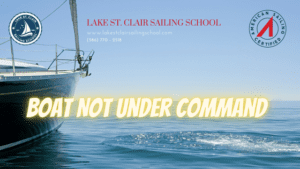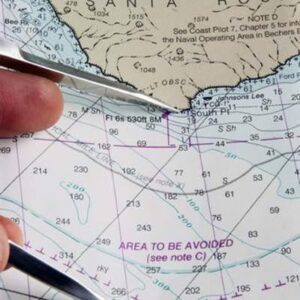ASA 104 Intermediate Coastal Cruising (Bareboat Charter)
Cruise Planning
- 1. Describe appropriate clothing and personal gear to pack for safety and comfort during a one-week cruise.
- 2. Describe the required documents and procedures for customs and immigration when cruising to a foreign port of entry.
- 3. Plan a menu and create a provisioning list for a one-week cruise.
- 4. Describe the symptoms and first aid treatments for hypothermia and heat exhaustion / heat stroke.
- 5. Describe the causes, prevention and treatments for seasickness.
- 6. Describe the tools and spare parts that should be on board for a one-week cruise.
- 7. Describe variables that affect fuel consumption and cruising range under power, and calculate range based on average fuel consumption.
- 8. Describe the minimum daily water requirements for all personnel on board as well as methods to conserve fresh water.
Systems
9. Describe safe galley procedures to minimize dangers such as fire, scalding, and spillage.
10. Describe proper marine toilet operation, including precautions to prevent malfunction, and describe proper holding tank pump-out procedures.
11. Identify and describe the function of the fundamental systems and components of a marine diesel engine, including fuel, lubrication, cooling, and drive train.
12. Describe safe fresh water tank filling procedures, including identification of correct deck fills.
13. Describe power conservation measures and procedures to prevent running batteries down when anchored/moored overnight.
Emergencies
14. Name four acceptable distress signals, per the USCG Navigation Rules and Regulations Handbook, which are appropriate for a recreational vessel.
15. Describe actions to be taken in the following situations:
- • Collision with another boat
- • Running aground
- • Dragging Anchor
- • Flooding
- • Fire
16. Describe actions to be taken in the following situations when the vessel is under power:
- • Fouled Propeller
- • Engine cooling water fails to flow
- • Engine fails in a crowded anchorage where using sails is not possible • Engine fails in a busy channel
Seamanship
17. Describe the information required and the procedure for tying a boat to a fixed dock in areas with a large tidal range.
18. Describe the following multiple-anchor mooring procedures and their purposes:
- • Fore & Aft Moor
- • Forked Moor
- • Bahamian Moor
- • Mediterranean Moor
19. Describe methods and potential dangers of rafting vessels at anchor. 20. Describe safe methods for towing and securing a dinghy / tender.
21. Describe preparation of the vessel for heavy weather sailing including gear stowage, crew safety and appropriate sail plan.
22. Describe the following courtesies and customs:
- • Permission to board
- • Permission to come alongside
- • Courtesy in crossing adjacent boats when rafted
- • Rights of first boat in an anchorage
- • Keeping clear of regattas
- • Flag etiquette
- • Rendering assistance to vessels in distress
23. Describe, using diagrams as appropriate, the applicable rules (steering & sailing, lights, and sound signals) for a 30’ to 45’ recreational vessel, as found in the USCG Navigation Rules and Regulations Handbook.
Navigation & Weather
24. Explain and identify the following coastal navigation terms, using a chart or diagrams as appropriate:
• Speed Time Distance Tidal Range Tidal Current Track Course Heading Bearing Fix True Magnetic Variation Deviation Line of Position (LOP)
25. Describe the sea breeze and land breeze dynamics and their effect on sailing conditions.
26. Identify conditions that may lead to the formation of radiation and sea / advection fog.
27. Describe actions to be taken in the following weather situations:
- • Fog / reduced visibility
- • Squall / thunderstorm
SKILLS
General
28. Perform the duties of skipper and crew on a live-aboard coastal cruise of at least 48 hours
29. Locate and check the condition of all federally required equipment.
Systems
30. Perform a routine vessel inspection, ensuring that all systems and equipment are in working order, including:
• Fuel level Fresh water level Battery voltage Electrical system Navigation lights Instruments and electronics Bilge Through-hulls and seacocks Standing rigging Running rigging Deck hardware Ground tackle
31. Visually inspect the auxiliary engine. Check for correct engine oil level and potential problems such as leaking fluids or frayed belts; demonstrate safe engine starting, operating and stopping procedures.
32. Inspect the raw water strainer for debris and ensure that the raw water intake seacock is in the proper position for engine operation.
33. Locate the emergency steering tiller and identify where it attaches to the rudder post.
34. Operate the electric and manual bilge pumps to ensure they are functional.
35. Demonstrate proper usage of the VHF radio, including hailing another station on Channel 16 and switching to a working channel.
36. Demonstrate proper operation of the galley stove including fuel supply, lighting, and shutting down; simulate the proper way to extinguish a galley fire.
37. Demonstrate the proper method of disconnecting and reconnecting shore power cables.
Under Power
38. Demonstrate the use of spring lines in the docking/undocking process (e.g., pivoting the vessel away from the dock during departure).
39. Maneuver the vessel in reverse gear, observing and explaining the effect of prop walk on the stern’s direction.
40. Maneuver the boat in a confined space to include performing ‘standing turn’ maneuver, turning the vessel 180 degrees in a confined area using rudder position and gearshift / throttle control.
41. Ensure vessel / crew readiness and use the auxiliary engine to bring the vessel smoothly and under control to a stop next to a parallel dock or into a slip; secure the vessel using appropriate lines and fenders.
42. Describe/demonstrate an appropriate person in water (a.k.a. Man Overboard or MOB) recovery maneuver while under power and describe methods to bring the MOB safely back aboard.
43. Demonstrate one of the following multiple-anchor mooring methods as appropriate to local conditions, using correct procedures such as hand signals, safety in handling ground tackle, proper operation of windlass (if equipped) and use of a snubber or bridle. Raise anchors and get underway smoothly using correct procedures.
- • Fore and Aft Moor
- • Forked Moor
- • Bahamian Moor
- • Mediterranean Moor
- Under Sail
44. Sail a steady compass course within +/- 10 degrees with sails trimmed properly.
45. Demonstrate the proper use of all available lines and sail controls (halyards, sheets, traveler, boom vang, outhaul, downhaul/cunningham, jib sheet fairleads, etc.) to obtain maximum performance and comfort.
46. Demonstrate the correct usage of a jibe preventer.
47. Demonstrate proper reefing procedures while under sail or hove-to.
48. Demonstrate two different MOB recovery maneuvers while under sail; starting from both close-hauled and a broad reach and selecting an appropriate maneuver for each initial point of sail.
Navigation & Weather
49. Plan a coastal passage from origin to destination, plotting courses, distances, and waypoints. While en route, keep a written log and plot DR positions on a chart, and calculate estimated times of arrival (ETA) to waypoints.
50. Obtain and interpret marine weather information; describe the impact that the present observations and forecast may have on cruising plans over a 3-day period.
51. Obtain updated weather forecasts during a passage and compare with visual and measured observations.
52. Take visual 2 or 3-bearing fixes using a hand-bearing compass.
53. Determine the predicted depth above or below chart datum at a given time using tide prediction tables.
54. Use a GPS / chartplotter (if available) to obtain information and perform basic navigation functions such as position, course, speed, waypoints, ETA, and tidal information.
55. Pilot a boat into an unfamiliar harbor or anchorage by day using relevant nautical charts, publications and tidal information.
Knots
Describe the purpose of and construct each of the following knots (without assistance and in a timely manner):
- Figure-8
- Knot Square (Reef)
- Knot Clove Hitch
- Round Turn & 2 Half Hitches
- Cleat Hitch
- Bowline Sheet Bend
- Rolling Hitch
- Trucker’s Hitch




